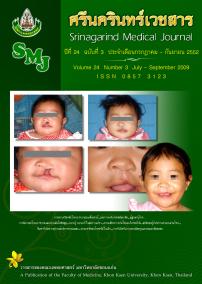ThaiScience
ThaiScience
SRINAGARIND MEDICAL JOURNAL
Volume 36, No. 01, Month JANUARY, Year 2021, Pages 30 - 47
Hearing screening of newborn at newborn intensive care unit, roi et hospital
Chairat Sererat, Wipada Sererat
Abstract Download PDF
Objective: To study the hearing screening of newborn at Newborn Intensive Care Unit. Methods: This was a retrospective study, all data were retrieved from medical records of 729 cases at Newborn Intensive Care Unit, Roi Et Hospital during October 1, 2013 to July 31, 2019. The hearing loss screenings were used Distortion-product otoacoustic emissions (DPOAEs) by audiologist took time for 1-2 minutes per ear. The sound used for examination was loudness approximately level 60-70 decibels which was not harmful to ears and hearing of infant. The echo measurement was performed by audiologist by insert probe to outer ear canal of infant. Then released sound to stimulate and record the response of the inner ear. The machine will automatically process and reported the results that Pass or Refer. The statistics used for data analysis were descriptive statistics, Chisquare test and Fisher’s Exact test. The statistical significance was set at p <0.05. Results: Of 729 infants most of them were male 59.67%, preterm birth 42.25%, birth weight < 1,500 gram 15.09%, hearing screening Pass both ear 90.53%, Refer both ear 4.66%. Right ear Refer 1.23%, Left ear Refer 0.27%. The factors associated with hearing loss of infants in Newborn Intensive Care Unit were Craniofacial anomalies (p=0.001), Ototoxic medication (p=0.019), Low apgar score (p=0.036), On mechanical ventilator (≥7 days) (p=0.011) and Stigmata associated syndrome to include Stigmata associated syndrome to include sensorineural hearing loss 1 conductive hearing loss (p=0.026). Rate of hearing screening was 97.07%, referral rate was 4.66% and follow up rate was 47.05%. Of 6 infants has diagnosed for hearing loss (0.83 %), received hearing aid 5 cases, and loss follow up 1 case. Conclusion: This study revealed that the hearing loss screening of newborns in high risk group at the Neonatal Intensive Care Unit that very important. It was found out that the risk factors of hearing loss of newborn had several factors. The newborns at risks should be monitored and continuously to treated, if abnormalities were found the treatment and recovery should promptly performed.
Keywords
Hearing screening; newborn; Newborn Intensive Care Unit; Hearing lossSRINAGARIND MEDICAL JOURNAL
Published by : Faculty of Medicine, Khon Kaen University
Contributions welcome at : http://www.smj.ejnal.com/e-journal/journal/index.php
